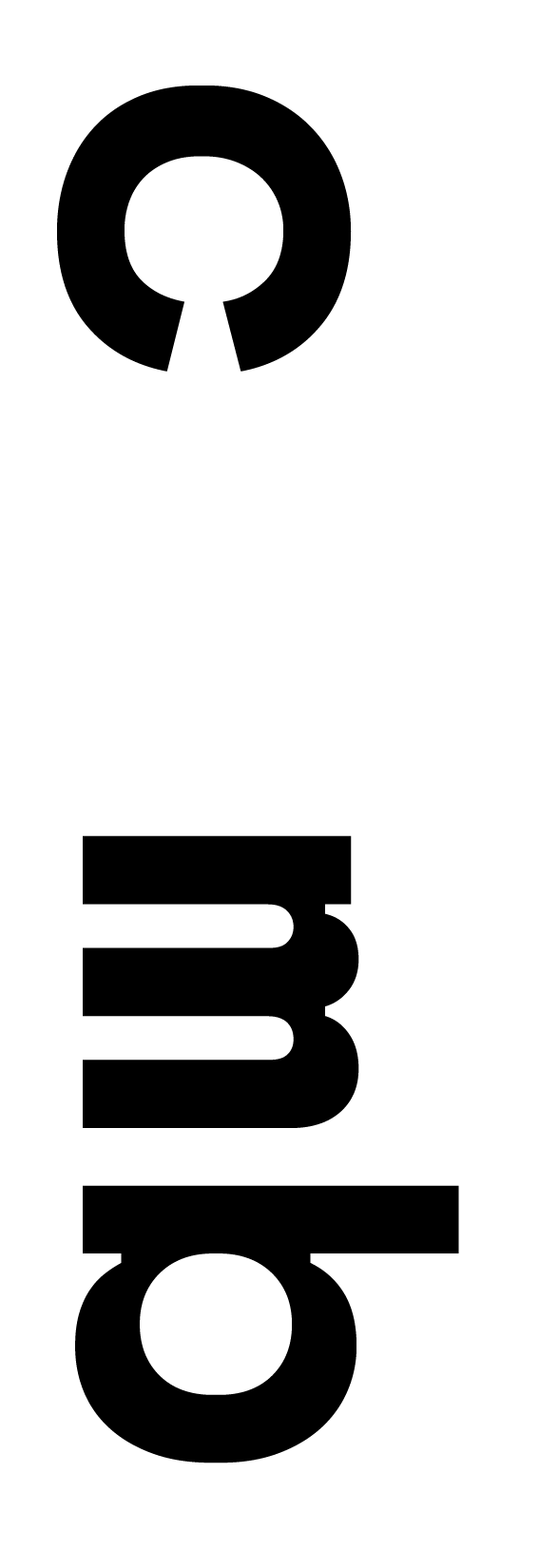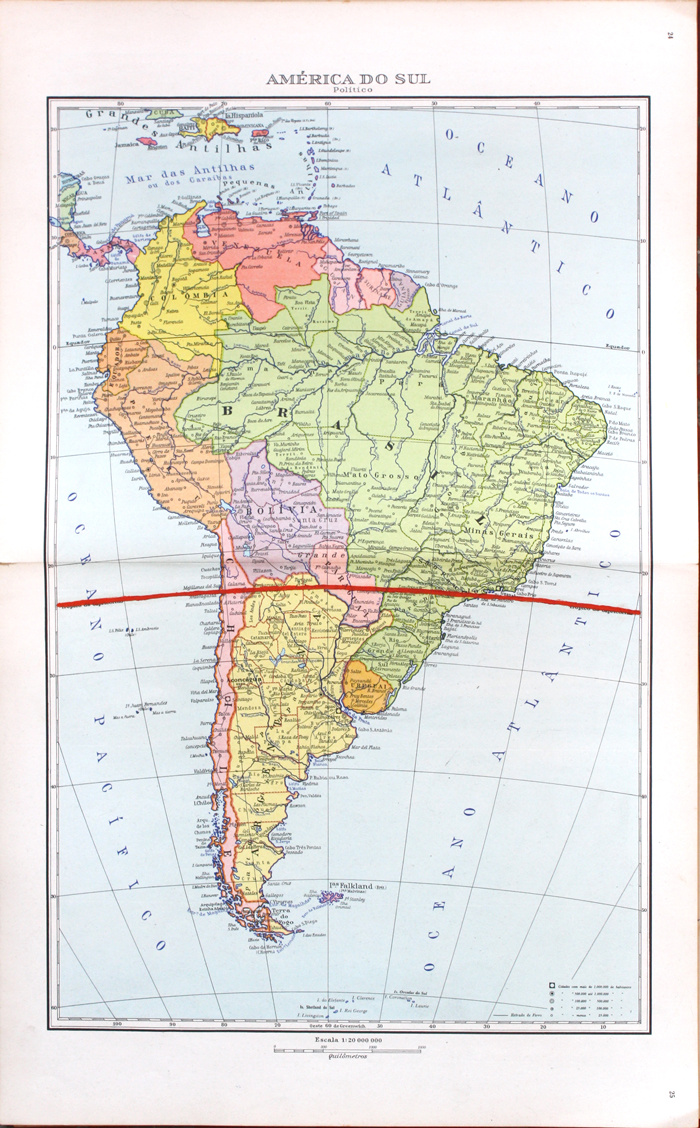ARC
Frederico Filippi
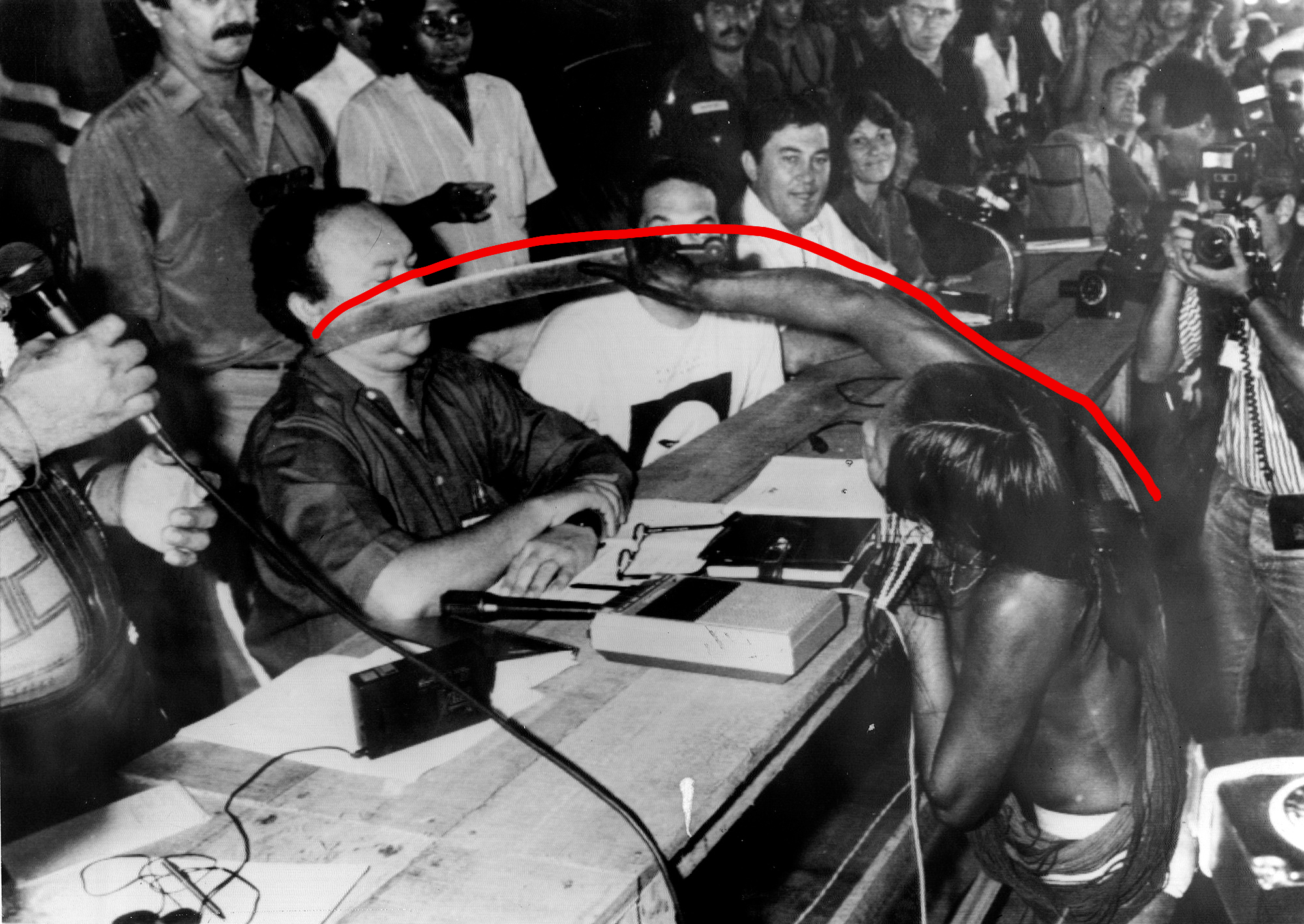 Tuirá Kayapó during a hearing about the Kararaô Power Plant. Photo: Protássio Nêne/Estadão Conteúdo-1989 with author's intervention.
Tuirá Kayapó during a hearing about the Kararaô Power Plant. Photo: Protássio Nêne/Estadão Conteúdo-1989 with author's intervention.The arc of deforestation is the name currently given to the form of the industrial and agricultural frontier advancing toward the northwest Amazon, which began in the 1970s. It is so called because today it is composed, according to IPAM (Amazon Environmental Research Institute), of "500,000 km2 of land stretching from eastern and southern Pará westward through Mato Grosso, Rondônia and Acre".
The arc formed on the map is a nuisance to the immunity of form. It is an abstraction of territory, of borders; no one can see this arc with the naked eye. Its existence as a geometric figure is an inference, because it is a set of shapes so irregular that the arc is an arc only with a certain distance, just as every circle segment, without the same distance, is a line.
The arc presses its way into this colossal network of forests and has already subjugated a fifth of its length. It may be one of the segments of a larger wave, of uncertain epicenter and reverberating for some centuries, like the navigations that took place by sea currents or the migratory movements that expanded peristaltically across the terrains. Moving forward and backward, pushing with pulse and rhythm.
This arc can be described in terms of extent, thickness, and materiality, but it can also be described by its impermanence, indeterminacy, and mutability. It is impermanent and varies in intensity and frequency. If we retreat the advance, we will depend on the process of secondary forest recovery that can take around 70 years. In the case of deepening of the exploratory process, the next passage of the SIVAM1, INPE2, or other satellites will show the previous parallelogram transformed into a composition of new rhombuses, semi-circles, (less frequent in the Brazilian portion of the Amazon) rectangles, and irregular polygons agglutinated with the speed at which a pack of tractors is capable of drawing them.
[1] SIVAM – Amazon Surveillance System (Sistema de Vigilância da Amazônia) installed in the 1990s for satellite monitoring in the Legal Amazon territory
[2] INPE – Space Research Institute (Instituto de Pesquisas Espaciais)
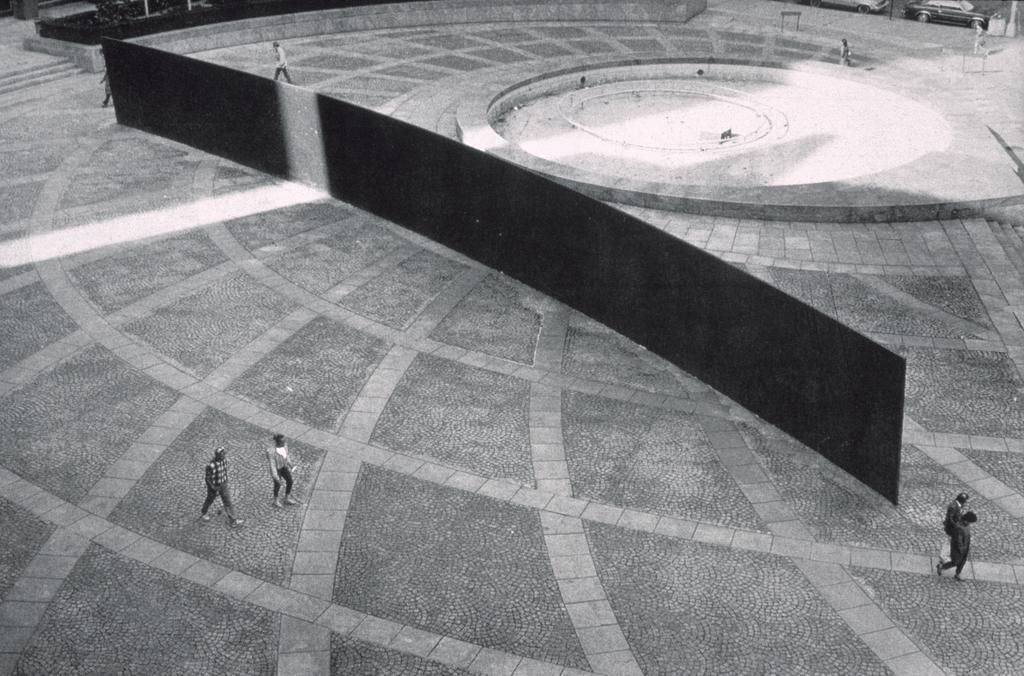 Tilted Arc, Richard Serra, 1981. Steel sculpture (36.6m X 3.6 m). Federal Plaza, New York, USA.
Tilted Arc, Richard Serra, 1981. Steel sculpture (36.6m X 3.6 m). Federal Plaza, New York, USA.
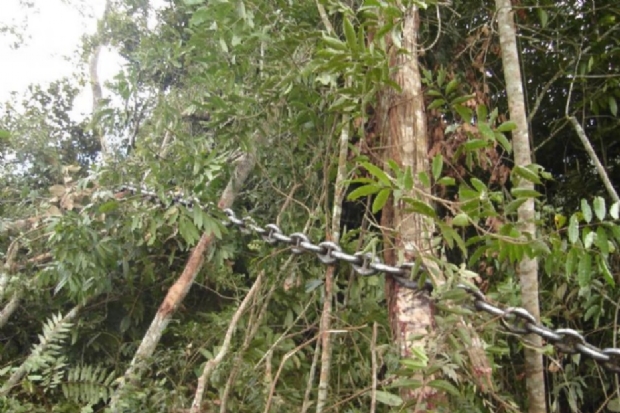 Photo: Rogério Florentino / Olhar Direto
Photo: Rogério Florentino / Olhar Direto***
Tuirá Kayapó rubs her machete on the face of José Antônio Muniz, director of Eletronorte Company, at a hearing in Altamira on the occasion of a 1989 protest against the Kararaô plant, now Belo Monte. The engineer has his cheek pressed by the blade of the machete, which forms an arc that extends from the woman's arm to the tip of the blade. In the central part of the photo, above the meeting of the hand next to the handle, you can see the wide eyes of a figure. Under the friction of the metal against the skin, hands crossed on the table, José Antônio keeps his eyes closed. It is possible to deduce from other archival images that Tuíra's machete has a worn edge.

Metallography of steel alloy used in big knives and machetes
It is not possible to draw a line between two points on the planet. A straight line on a map is a curved line on terrain. A straight line on terrain is a curve on a map. The importance of cartography in our relationship with the world allowed the propagation of arcs. Once the lines are drawn on the map, a sense of division and orientation sets in.
Within a forest, every straight line is a knot. Refuse the knot, and thus produce an arc. With the arc, separate two fields, two irreconcilable views, before the arc, and after the arc.
From inside the arc, facing concavity:
Concave
What advances;
EACH PROGRESSION IS INDEBTED TO THAT WHICH PRECEDES IT
[3]The prerogative to remain hidden is the offense of concavity to convexity.
From inside the arc, facing convexity:
Convex:
An idea of an unprecedented and diffuse consciousness, lost in the eyes of a newcomer amidst the camouflage of the forest: they say that a jaguar has watched you for a long time when you see it. And when you don't see it too. The concave is what the convex wants to see, that's why it launches tractors, roads, satellites, anthropologists, biologists and artists.
The concave is confused with a vacuum: probably uninhabited. The contact between two things, microscopically, is mediated by one air molecule. This air molecule is a chasm between the propagation of the wave – the arc – and what it will digest.
EACH PROGRESSION IS INDEBTED TO THAT WHICH PRECEDES IT
[3] ALŸS, Francis. In a Given Situation. São Paulo: Cosac Naify, 2010.
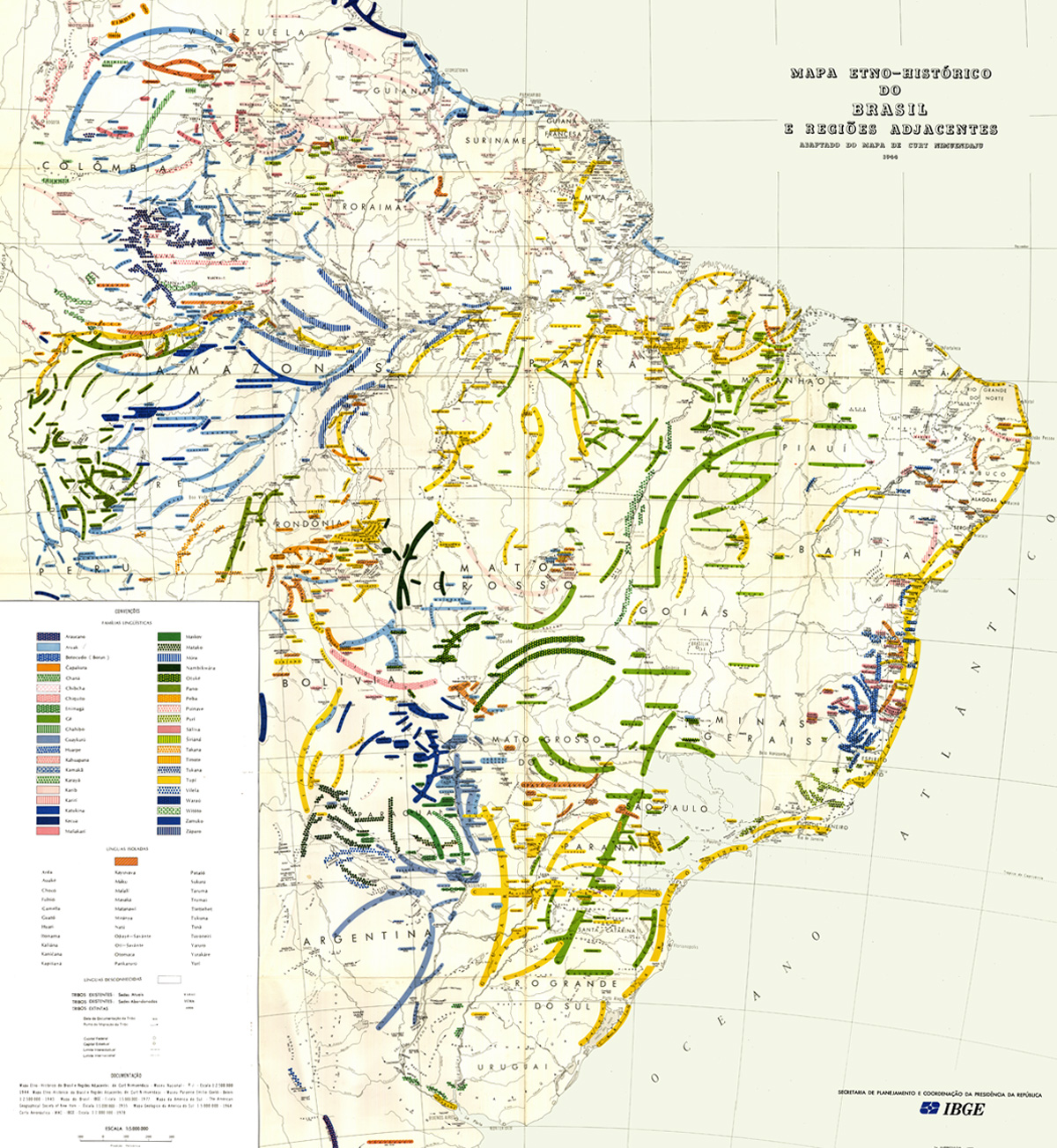
Ethnohistorical map of indigenous peoples and linguistic branches made by Curt Nimuendaju, final version 1944, published by IBGE in 1981. The map depicts occupation of territory in the form of arcs, instead of contingent territories.
The ideal of the arc is to no longer be an arc, it is to find the epicenter of its wave on the other side of the globe. Richard Serra said, regarding his Tilted Arc and its controversy (nuisance), that to remove the work is to destroy the work[4]. The nuisance, on Serra's part, was the use of public sculpture as a way of accommodating the status quo of architectural design and promoting a kind of appeasement. Removing the arc is a condition for the existence of the arc. The two ends of the arc are a taut string with a pointed arrow:
Frederico FIlippi. Retrasados, 2021. Marble. 42 cm in diameter x 17 cm in height.
KIOSKO Collection, Santa Cruz de la Sierra.
KIOSKO Collection, Santa Cruz de la Sierra.
[4] Carta de Richard Serra para Donald Thalacker, datada de 1º de janeiro de 1985, publicado por Clara Weyergraf-Serra e Martha Buskirk (eds.) em The Destruction of Tilted Arc: Documents (Cambridge: MIT Press, 1991), p. 38.
“What had happened? It must be assumed that something bent the arrow of time, an ancient and also unpredictable power that at first worried, then bothered, until it finally dispersed the projects of the Moderns of yore. As if the expression “modern world” had become an oxymoron. Either it is modern and there is no world underfoot, or there is a real world, but it cannot be modernized. It’s the end of a certain historical arc.” [5]
[5] LATOUR, Bruno. Where to Land? - How to Become Politically Oriented in the Anthropocene. Ed. Bazar do Tempo, São Paulo, 2020. P. 30
Parallax: Southwest

Photo: O Globo archive
While in the late 1960s artists are isolating themselves in the North American deserts, moving huge amounts of earth with machines and thousands of dollars and questioning concepts of landscape, industry, time, materiality and value, tractors and backhoes (probably similar to the ones that Robert Smithson called Robert Morris's paint brush [7]) are opening immense trenches in an absolutely humid territory, where you can't see the horizon with your feet on the ground, maybe not even three meters ahead, and yet it's considered infinite.
These are the Trans-Amazonian roads (BR 320), the Cuiabá-Santarém (BR 363), the North Perimeter (BR-210) and the Phantom Highway (BR-319). Transforming a landscape into a grid, planners drew their lines over empty spaces on maps. A void incompatible with a territory full of matter, whose impenetrability gained in these maps the figure of a hollow abyss or a whirlpool vortex that sucked everything [8], on which was written Amazon.
Cartography and aerial images were essential indices for the appreciation of many of the works of land art. Lucy Lippard states that when land art was something new, it offered an expansion of consciousness that was both aesthetic and experiential, but which, looking back today, as in a rear-view mirror, brings a different view of the macropronouncements [9] of that type of work.
"The spectator, like the artist, is so amazed, so touched, so attentive to seasons and materials, space and wildlife, that the work actually coexists with the place it creates [...] Forty years later, climate change, resource scarcity, drought threats and federal administrations dedicated to destroying the environment for corporate gain have changed the rules of the game" (LIPPARD, P. 87-88).
“In fact, I've come to the reluctant conclusion that much of land art is a pseudo rural art made from metropolitan headquarters, a kind of colonization in itself.” [6]
[7] In the original : « Instead of using a paintbrush to make his art, Robert Morris would like to use a bulldozer. » in the text « Towards the Development of an Air Terminal Site, 1967 ». FLAM, Jack (edit.) Robert Smithson: The Collected Writings, University of California Press, Ltd., London, England, 1996 (52-60).
[8] In the North, the water from drains and toilets flows in one direction and in the South, in the opposite direction.
[9] What Lippard calls a macropronouncement concerned the ambitions of these artists, whose most emblematic works were Robert Smithson's Spiral Jetty, Michael Heizer's City Complex and Double Negative, Nancy Holt's Sun Tunnels, Charles Ross' Star Axis, Roden Crater by James Turrell and the earth removals by Robert Morris. Lippard points out that all were white men, with the exception of Nancy Holt, and recalls that it was very difficult for female artists to get the kind of funding needed for ventures like this.
Reduction

Schwarzwald, 2010. Michael Sailstorfer. The black painted fragment in the forest is recorded 24h on a monitor inside a gallery to accompany modifications made by chopping.
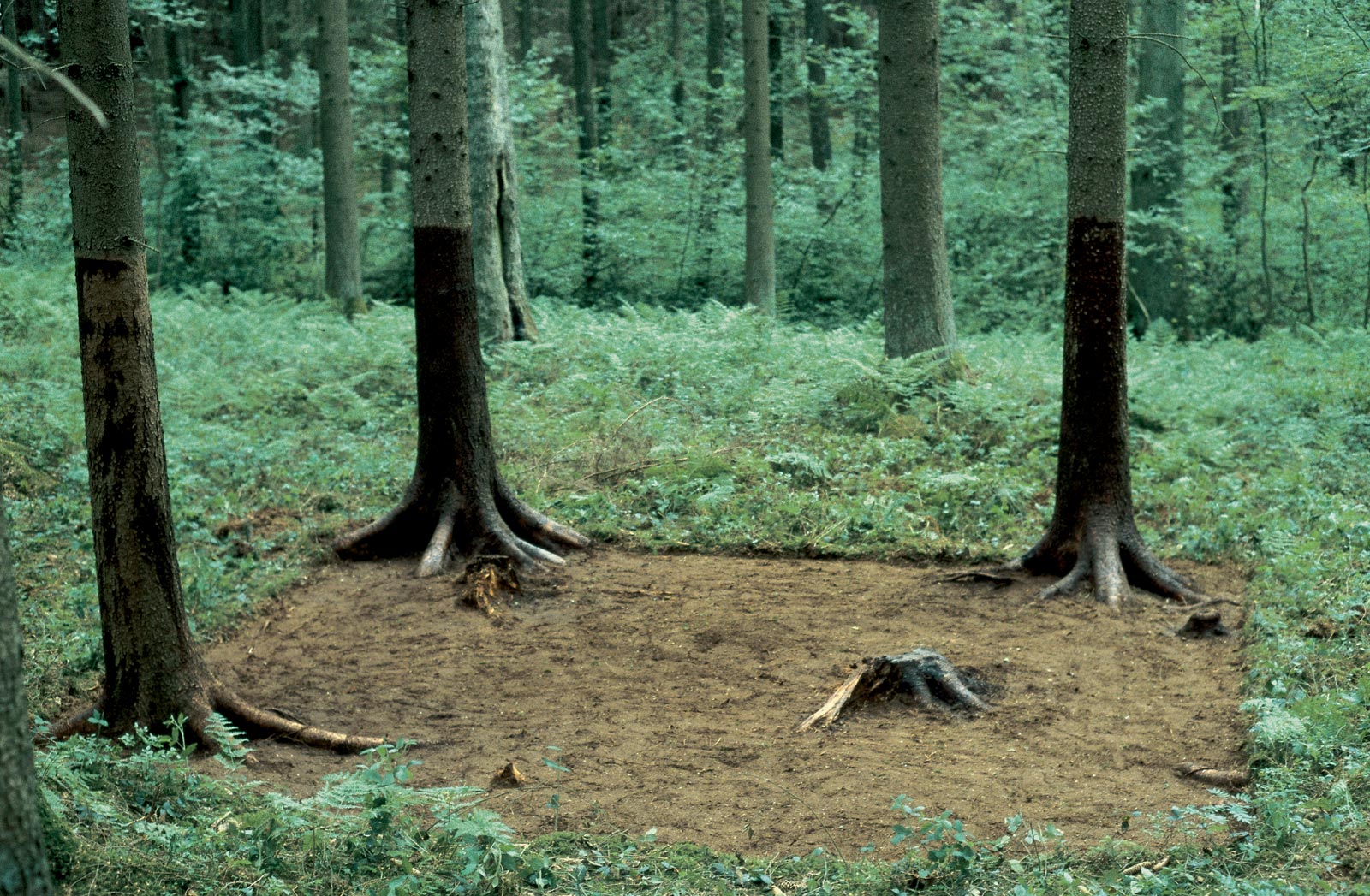 Waldputz, 2000. Michael Sailstorfer
Waldputz, 2000. Michael Sailstorfer
An organism digesting what preceded it, transforming the unintelligible that lies ahead into a construct, an enzyme, breaking down, molecule by molecule, an enormous carcass, without haste, leaving residues and by-products that we can classify and that serve as our names. The seams between the parts begin to loosen, a crust adds on top what it takes from below. Corrosion is a kind of generalization: it undoes what is specific and transforms it into a replicated pattern, a system of fragmentation and separation. Simultaneously decreasing and multiplying, a negative and cumulative operation, deforestation subtracts and embodies the prophecy of Antônio Dias, a negative country.
Memory
Memory
Memory
Memor
Memory
Memory
Memor
*Monument to memory – excerpt taken from
Antonio Dias’ notebooks, displayed at
the Antonio Dias exhibition/ Archive/ The place of work,
curated by Gustavo Motta at the Institute
of Contemporary Art, São Paulo, 2021.

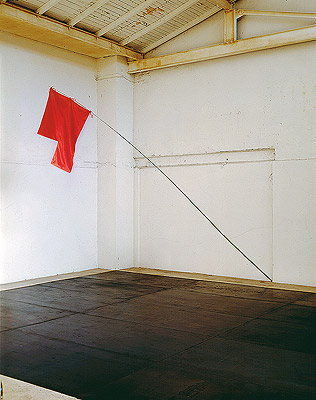
Antonio Dias. The invented country, 1976.
Photo: Udo Grabow
The arc of deforestation is a machine of generalization and discontinuity, which considers every difference inherent in an inexpressive forest, indistinguishable to the point of removing it completely and turning it into an open field, identical to the one before its advance: the debt.
This reduction dispenses with the characteristics of that place in its entirety because it wants to transform it into another. In the name of fragmentation, a body is being shredded little by little, to be better digested and transformed into heat, a form of degraded energy whose absolute magnitude is entropy. “You have a closed system that eventually deteriorates and starts to fall apart and you have no way of putting all the pieces back together again.” [11]
Entropy is digestion within another. A mirroring, an abyss within another, a seven-layered stomach eating what's inside. Once in the Amazon, I heard from a man who grew bananas that the forest floor is an open stomach: everything that falls into it starts to be devoured. Composting is the name of this digestive system. When you put your foot on a forest floor, it starts to be eaten, microorganisms eat some bigger things, which eat some smaller things, which divide bigger things into smaller ones and agglutinate smaller things into bigger things and, in short, if something stays still for a long enough time on the forest floor, it is already presumed dead, ready to be reinstated.
This same stomach is being eaten by an arc, a segment of a circle, by a reverberation of a wave, which will eat the previous one. This microscopic stomach is also a stomach of a thousand stomachs, connected to each other underground in a digestive and communicative web.
![]()
This plot is being eaten by a larger plot. It is being cut into digestible pieces. This larger plot that eats the stomachs of a thousand smaller stomachs that eats the bare feet of those who stand around long enough thinking about these sorts of things is being eaten by itself, but belatedly.
What is behind the concavity of the arc is an open plane, it is no longer an arc. And the arc, moving indefinitely, walks towards its own extinction, eroding and reducing itself. Disintegrated, whole, finally complete.
[11] SKY, Allison. Entropy Made Visible. 1973 In: FLAM, Jack (ed.). Robert Smithson: the collected writings, Berkeley: University of California Press, 1996. P. 301
This reduction dispenses with the characteristics of that place in its entirety because it wants to transform it into another. In the name of fragmentation, a body is being shredded little by little, to be better digested and transformed into heat, a form of degraded energy whose absolute magnitude is entropy. “You have a closed system that eventually deteriorates and starts to fall apart and you have no way of putting all the pieces back together again.” [11]
Entropy is digestion within another. A mirroring, an abyss within another, a seven-layered stomach eating what's inside. Once in the Amazon, I heard from a man who grew bananas that the forest floor is an open stomach: everything that falls into it starts to be devoured. Composting is the name of this digestive system. When you put your foot on a forest floor, it starts to be eaten, microorganisms eat some bigger things, which eat some smaller things, which divide bigger things into smaller ones and agglutinate smaller things into bigger things and, in short, if something stays still for a long enough time on the forest floor, it is already presumed dead, ready to be reinstated.
This same stomach is being eaten by an arc, a segment of a circle, by a reverberation of a wave, which will eat the previous one. This microscopic stomach is also a stomach of a thousand stomachs, connected to each other underground in a digestive and communicative web.
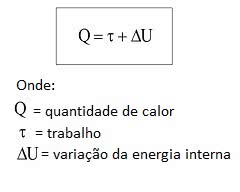
What is behind the concavity of the arc is an open plane, it is no longer an arc. And the arc, moving indefinitely, walks towards its own extinction, eroding and reducing itself. Disintegrated, whole, finally complete.
[11] SKY, Allison. Entropy Made Visible. 1973 In: FLAM, Jack (ed.). Robert Smithson: the collected writings, Berkeley: University of California Press, 1996. P. 301
BIBLIOGRAPHY
ALŸS, Francis. In a Given Situation. São Paulo: Cosac Naify, 2010.
ALŸS, Francis. A story of Deception/ Historia de um desengano. Patagonia 2003/2006. Catálogo da exposição. Buenos Aires: Malba – Colección Constantin, 2006.
BARBOSA, Antonia; RANZI, Alceu; SCHAAN, Denise; SILVA, Arlan. “Construindo paisagens como espaços sociais: o caso dos geoglifos do Acre”. Revista de Arqueologia, Volume 23 – N.1:30-41-2010.
BARBOSA, Antonia; RANZI, Alceu; SCHAAN, Denise (org.) “Geoglifos: Paisagens da Amazônia Ocidental”. Rio Branco: GKNoronha, 2010.
BUCHLOCH, Benjamin H. Conceptual Art 1962-1969: From the Aesthetic of Administration to the Critique of Institution. October. Cambridge: MIT Press. Vol. 55 (Winter, 1990), p. 105-143. Disponível em: <http://www.jstor.org/stable/778941>.
CELANT, Germano. Art Povera. Praeger Publishers INC, New York, 1069
ALŸS, Francis. In a Given Situation. São Paulo: Cosac Naify, 2010.
ALŸS, Francis. A story of Deception/ Historia de um desengano. Patagonia 2003/2006. Catálogo da exposição. Buenos Aires: Malba – Colección Constantin, 2006.
BARBOSA, Antonia; RANZI, Alceu; SCHAAN, Denise; SILVA, Arlan. “Construindo paisagens como espaços sociais: o caso dos geoglifos do Acre”. Revista de Arqueologia, Volume 23 – N.1:30-41-2010.
BARBOSA, Antonia; RANZI, Alceu; SCHAAN, Denise (org.) “Geoglifos: Paisagens da Amazônia Ocidental”. Rio Branco: GKNoronha, 2010.
BUCHLOCH, Benjamin H. Conceptual Art 1962-1969: From the Aesthetic of Administration to the Critique of Institution. October. Cambridge: MIT Press. Vol. 55 (Winter, 1990), p. 105-143. Disponível em: <http://www.jstor.org/stable/778941>.
CELANT, Germano. Art Povera. Praeger Publishers INC, New York, 1069
DANOWSKI, Déborah; Viveiros de Castro, Eduardo. Há mundos por vir: ensaio sobre os medos e os fins. 2ª edição. Desterro (Florianópolis): Cultura e Barbárie. Instituto Socioambiental, 2017.
DAVIS, Heather; Turpin, Etienne (eds.) Art in the Anthropocene: Encounters among aesthetics, politics, environments and epistemologies. Londres: Open Humanities Press, 2015.
FLAM, Jack (ed.). Robert Smithson: the collected writings. Berkeley: University of California Press, 1996.
GELL, Alfred. Arte e Agência: Uma Teoria Antropológica. São Paulo: Ubu Editora, 2018.
GERMANN, Martin, GOLDMANN, Renate, SAILSTORFER, Michael, Günther-Peill-Stiftung, Leopold-Hoesch-Museum, (eds.) Michael Sailstorfer. Berlin: Nicolai, 2010.
HARAWAY, Donna. Staying with the Trouble: Making kin in the Cthulhucene. Duke University Press, Durham e Londres, 2016. 296 páginas
KINKLE, Jeff; TOSCANO, Alberto. Cartographies of the Absolute. Zero Books, Alresford, Hants, United Kingdom, 2015.
KRAUSS, Rosalind. Sculpture in the Expanded Field. October. Cambridge: MIT Press. Vol. 8, pp. 30-44, (Spring, 1979). Disponível em: <https://www.jstor.org/stable/778224>.
krauss_voyage-on-the-north-sea.pdf
KWON, Miwon. One Place after Another: Notes on Site Specificity. October. Cambridge: MIT Press. Vol. 80. (Spring, 1997), p. 85-110. Disponível em: https://www.jstor.org/stable/778809
LATOUR, Bruno. Onde Aterrar? - Como Se Orientar Politicamente no Antropoceno. Ed. Bazar do Tempo, São Paulo, 2020. 160 páginas
LIPPARD, Lucy. Undermining: a wild ride through land use, politics, and art in the changing West. New York, The New Press, 2013.
LIPPARD, Lucy. Six Years: The dematerialization of the art object from 1966 to 1972. Nova York: Praeger, 1973.
LAILACH, Michael. GROSENICK, Uta (Ed.) Land Art. Köln: TASCHEN GmbH, 2007.
PEIXOTO, Nelson Brissac. Paisagens Críticas: Robert Smithson: arte, ciência e indústria. São Paulo, EDUC; Editora Senac São Paulo; FAPESP, 2010. 406 p.
SEKULA, Allan. The Instrumental Image: Steichen at war, Artforum, 14.4, 1975, p.30
STEYERL, Hito. In Free Fall: A thought experiment on vertical perspective´ em The Wretched of the Screen (Berlin: Sternberg Press, 2012), p. 26
TSING, Anna Lowenhaupt. Frictions – An Etnography on Global Connection. Princeton: Princeton University Press, 2005.
VIDAL, Lux (org.). Grafismo indígena – Estudos de antropologia estética. São Paulo: Studio Nobel; FAPESP; Editora da Universidade de São Paulo, 1992.
